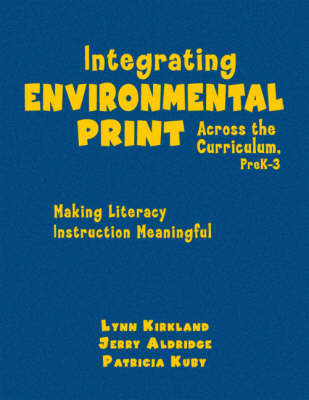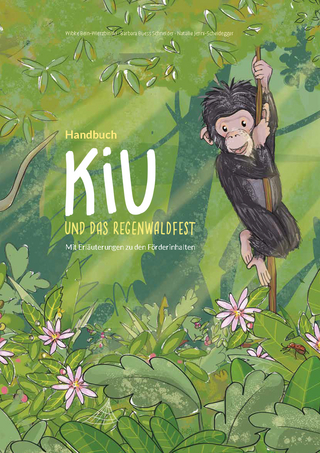
Integrating Environmental Print Across the Curriculum, PreK-3
Corwin Press Inc (Verlag)
978-1-4129-3757-3 (ISBN)
- Titel ist leider vergriffen;
keine Neuauflage - Artikel merken
From billboards to lunch boxes, environmental print offers a powerful springboard to literacy!
While learning to read and write takes time, there are effective ways to tap into what children already know and to use that information to jump start the literacy process. One way is through environmental print (EP), the print that surrounds children in their daily lives.
Integrating Environmental Print Across the Curriculum, PreK–3, provides a wealth of activities that build literacy skills during time devoted to language arts, math, science, social studies, art, and dramatic play. Highlighting research from the National Reading Panel, the authors demonstrate that by activating prior knowledge and creating opportunities for authentic learning, EP is an effective tool in developing the early literacy skills of all children, including English language learners and those at risk for, or identified with, special needs. Each activity specifies grade range, materials, and instructions to help you:
Meet the goals of Early Reading First and Reading First
Assess children′s ability levels in performing the activity
Strengthen concepts with related literature and songs
Communicate ways that parents can use EP with their children
This friendly, research-based book is designed to assist you in creating an environmental print program that promotes the development of strong literacy skills for every child!
Lynn Kirkland is associate professor of early childhood education at The University of Alabama at Birmingham (UAB). She also directs the UAB Children′s Creative Learning Center′s summer enrichment program for children. Kirkland has published numerous articles on early childhood and literacy development, and is co-author of Connectors: Content Area Studies in Early Childhood published by the Association for Childhood Education International. Jerry Aldridge is professor of curriculum and instruction and coordinator of the doctoral program in early childhood education at the University of Alabama at Birmingham. He is a former president of the United States chapter of the World Organization for Early Childhood Education and currently serves on the publications committee of the Association for Childhood Education International. Aldridge has published numerous articles in early childhood, literacy, and special education. Patricia Kuby, Ph.D., is professor and chair of early childhood education at Athens State University in Alabama. She learned to appreciate the importance of environmental print as her children read signs and logos while traveling on family car trips. Her three children are now all educators themselves. Patricia is past president of the Alabama Association for the Education of Young Children. She has published numerous articles on literacy development and early childhood.
Acknowledgments
About the Authors
Introduction
1. What We Know About Environmental Print and Young Children
The Conceptual Framework for Using Environmental Print
What We Know About Early Literacy
Research on Environmental Print
Environmental Print and Children With Special Needs
Environmental Print and No Child Left Behind
Summary of the Research Findings on Environmental Print
Appropriate Ways to Use Environmental Print Throughout the Curriculum
2. Language Arts Activities
Daily News
Posters and Signs
Dictionaries
Writing Experiences
Literacy Across Thematic Units
Rebus Stories
Wall Lists and Bulletin Boards
Pocket Charts
Text Innovations
Word Boxes
Book Boxes
Newspaper Ad Word Search
Recipes
Lunchboxes
Billboards
Alphabet Scavenger Hunt
Environmental Print Walk
Restaurant Menus
Alphabet Wall/Community Alphabet
Alphabet Books
Reading Inside the Box
3. Math Activities
Puzzles
Coupons
Graphs
Math Games
Math in an Integrated Curriculum
M & M′s Math
Newspaper Ads
Food Labels
Enlarged Class Texts
Lists
Grocery Store Surveys
Food Groups
4. Health and Science Activities
Making Flavored Milk
Peanut Butter and Jelly Sandwiches
Making M & M′s Coookies
Making Chicken or Vegetable Stew
Making Pizza
Making Pancakes
Pretend Shopping
Real Shopping
Good Food Versus Junk Food
Snacks--How Good Are They?
Where Does Food Go?
Pretend Restaurant
Matching Toothpaste
Planting Seeds
Using Cardboard Containers
Weather Symbols
Going on a Picnic
5. Social Studies Activities
Using the Newspaper
Postcard Travel
Mapping the Community
Community Helpers
Transportation Schedules
Home Sales and Rentals
Environmental Print Graphs and Elections
Careers and Environmental Print
Social Studies "Me Books" and Journals
Culturally Diverse Environmental Print
6. Creative Dramatics, Music, and Art Activities
Art Collage
Studying Artists
Neighborhood Mural
Me Boxes and "Myself"
Delivery Vehicles
MUSIC--Songs for Commercials
Creative Dramatics--"Centers" Stage
Musical Instrument Time
Can You Make a Puppet?
7. Meeting the Goals of the National Reading Panel Through Environmental Print Activities
Phonemic Awareness Activity: Starts Like...
Phonics Activity: Blended Environmental Print
Fluency Activity: Speedy Shopping List
Vocabulary Activity: What Goes With This?
Comprehension Activity: Where Do You Find It?
Conclusion: Challenges and Opportunities in Using Environmental Print
Reflective Teaching
Transformational Teaching
Resources
Resource A. Environmental Print Book List
Resource B. Sample Letter to Parents
References
| Erscheint lt. Verlag | 14.2.2007 |
|---|---|
| Verlagsort | Thousand Oaks |
| Sprache | englisch |
| Maße | 215 x 279 mm |
| Gewicht | 680 g |
| Themenwelt | Schulbuch / Wörterbuch |
| Sozialwissenschaften ► Pädagogik ► Vorschulpädagogik | |
| ISBN-10 | 1-4129-3757-4 / 1412937574 |
| ISBN-13 | 978-1-4129-3757-3 / 9781412937573 |
| Zustand | Neuware |
| Haben Sie eine Frage zum Produkt? |
aus dem Bereich


